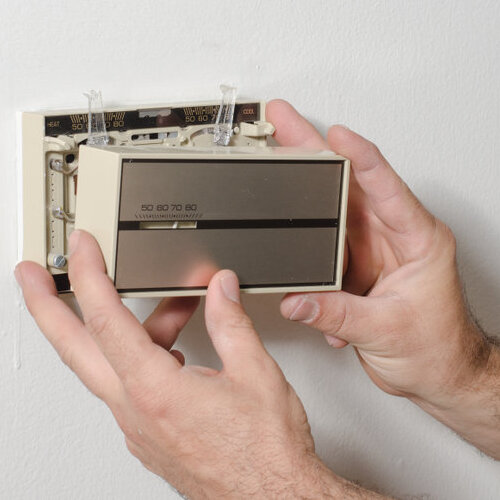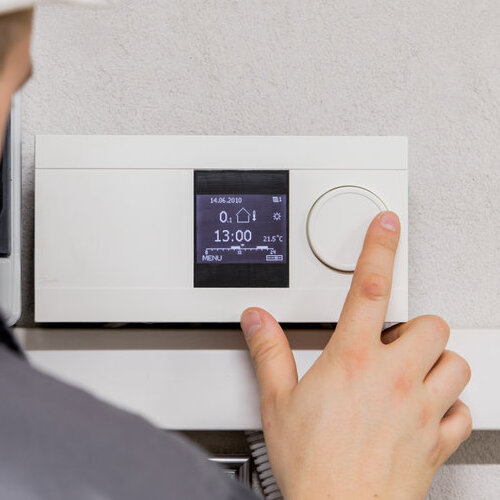
Understanding the Basics of Your HVAC Thermostat
Welllll… it looks like summer has arrived and is in full blast furnace mode here in Georgia! But already, folks are posting stuff on social media about how close Christmas is too! We’re already over the heat, and maybe your HVAC thermostat is too. You know what though? You’re going to need it working come cold weather too, so let’s talk about that today.
What does your HVAC thermostat do?
If you’re asking, “What is an HVAC thermostat?” you must not be the one that adjusts the temperature! A thermostat in general is a device that monitors the temperature of something. Your oven, clothes dryer, water heater – they all have a thermostat. Even your car has a thermostat. A thermostat, in general, works the same way as the thermometer you use to check your child’s temperature when they’re sick.
An HVAC thermostat measures the temperature inside your home and is connected to the HVAC unit. It automatically adjusts the cooling or heating to the temperature you have it pre-set to, telling it to blow out warm or cool air depending on if you have the HVAC system on ‘cool’ or ‘heat’.
How do you know if a house thermostat is bad?
So, maybe your house hasn’t been as cool as you think it should be. Of course, when the temperature is in the high 90s and the humidity is too, every HVAC in the state is working overtime, right? However, if your HVAC thermostat isn’t working properly, then your HVAC system isn’t going to be running efficiently. Every part of the HVAC system needs to be in the correct working order or you’re spending money on electricity and not getting the full benefit.
So, how to tell if your HVAC thermostat is bad – the following are six ways.
1. The System Turns Off and On
Remember, the HVAC thermostat has to communicate with the HVAC system, and it does this by sending signals back and forth. If the HVAC thermostat isn’t getting or sending the right signals to the HVAC system it will keep turning the system off and on, repeatedly. This could be a wiring issue or, if your HVAC thermostat is older than five years, you may need a new one.
2. Faulty HVAC Thermostat Readings
When the HVAC thermostat readings are right, your home should be comfortable and cozy. If the HVAC thermostat is incorrectly registering the indoor temperatures, it is time to replace it.
3. Questionable Energy Bills
Okay, it is summer and the electric bill is going to go up, but if it seems to have gone up more than expected, you might need to have the HVAC thermostat replaced.
4. Temperature Shifts Constantly
A faulty HVAC thermostat is able to maintain the settings you have in place and will continuously change settings without you doing anything. Lower the setting and see if the HVAC system turns on and stays on or goes back up then down again and up again.
5. Thermostat Is Old
As we mentioned earlier, the HVAC system has a lifespan of about 10 years, but if you’re having problems with it at five years, switch it out for a new programmable HVAC thermostat. It’ll work better and actually save you money each month.
6. Fails to Respond to Changes
If the HVAC thermostat doesn’t respond as soon as you make an adjustment, indicated by clicking sounds, then you need to replace the HVAC thermostat.
When should I replace my home thermostat?
Well, we just gave you six ways to tell that your HVAC thermostat isn’t working, and if you notice any of these problems it would be time to replace it. Another time would be if it is 10 years old or older, at which point we suggest you upgrade to a programmable unit. You can set a time for it to cut on and off, so your home is cooled off by the time you get home.
How much does it cost to replace an HVAC thermostat?
It can all depend on how fancy an HVAC thermostat you choose and if you install it yourself or have it installed. The thermostat itself can cost as little as $20 and up to $300 or more, with most homeowners spending around $100. If you have it installed by a professional electrician the cost will depend on their hourly rate or if they have a flat rate for this type of job – always ask! The hourly average is around $60, and some go as high as $100 per hour. You can expect them to bill you for a minimum of two hours.
In Conclusion
So, you’re thinking that it may be time for a new HVAC thermostat. Other questions to consider include what is the best HVAC thermostat? We recommend getting an HVAC thermostat with humidity control, it will do a lot of good for your home year-round to control that humidity. This is along with keeping your filter changed every 30 days and your air ducts professionally cleaned once a year. If you do that, your home will be comfortable temperature-wise – and healthier too! If you need professional HVAC service in Macon, GA, give Total Comfort Cooling & Heating, LLC a call at 478-781-9107 to set up an appointment.





